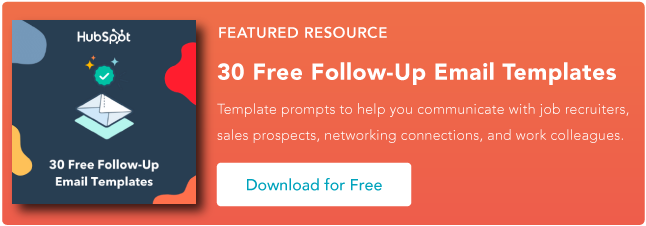Their ease is the reason that makes them so tempting to send, but they don't provide any value to your buyer. And if they never responded to your first email, chances are they didn't feel it was worth their time. Why would you reinforce that impression by wasting their time even more?
Of course, this doesn't mean that you should stop following up with prospects — just that you put slightly more effort into it. Below are 30 things to reference in a follow-up email besides the obvious fact that you're checking in.

If they never responded:
1. Send actionable advice.
Your messages should provide value to your prospects. Provide them with a short piece of actionable advice.
Example: “We see your business is trying to improve on X, we believe you could benefit from enacting Y for Z outcome.”
2. Send a how-to guide.
Email them a longer how-to guide. And offer to follow up over a phone or video call if they're interested.
Example: “We have attached a quick guide on how to X to help you achieve Y. If you’d like a more in-depth explanation, I can set up an appointment for discussion if you’re interested.”
3. Point out business weaknesses.
Send them a message about a weakness in their business that should be fixed, and offer assistance.
Example: “Your business has grown significantly over the last year, but that growth could be stunted by X weakness in your strategy. We’d like to schedule a meeting to offer you assistance in working through the matter.”
4. Describe a potential opportunity.
In your research, have you identified a potential opportunity for their company? Let them know. This will help you build a relationship as a trusted advisor with them.
Example: “Your business has more room to grow if you explore X opportunities. We’d like to schedule a meeting to offer you assistance in optimizing your strategy.”
5. Share a relevant industry article.
If you've found an article that's relevant to their industry or profession, send it to them instead of saying "just checking in."
Example: “We know your company is all about X, we thought you’d find value in this recent article analyzing the market for it.”
6. Respond on social media.
One important tool you can use to connect is social media. Respond to something the prospect said on social media, then follow up with more resources.
Example: “Hi! We saw your comment on X, not only do we have the answer you’re looking for, but we have some additional resources you’ll find useful, as well.”
7. Answer a question on an online forum.
Successful sales reps meet their prospects where they are. If they've posted on a forum, answer one of their questions and follow up with more resources.
Example: “We saw your question about X and wanted to provide you with some resources you’d appreciate on the matter. If you need any more clarification, don’t hesitate to reach out.”
8. Reference a relevant blog post.
Have they published a new post on their blog? Read it and include a reference to it in the message you send to them. This will further solidify that you're interested in them and their business.
Example: “I found your article to be so insightful to professionals navigating X, I learned so much more about X from it yesterday.”
9. Send them a blog post from your company.
On the other hand, if your company recently published a blog post that's relevant to the prospect, send it their way.
Example: “We know your company is making waves in the X industry, so we’d like to share our recent article with you to use as a resource for your mission.”
10. Recommend an event.
If there's an event in the prospect's area that's relevant to their industry or business, connect with them on that. Even if they already plan to attend, this is another way to rekindle the conversation.
Example: “We received news of an event in your region for X industry professionals, we hope to see you there.”
11. Invite them to a webinar.
Invite the prospect to an upcoming webinar or educational event your company is hosting.
Example: “You are cordially invited to join our company’s latest educational event next month, please RSVP if you’re interested.”
12. Send them a customer story.
Pass along a link to relevant press coverage of one of your highest-profile customers. This gives them an example of what's possible with your company.
Example: “Read our client success story with X and see how their profit grew Y% in a matter of weeks with our service.”
13. Call attention to a competitor.
Bring their attention to something their competitor is doing well and ask how they plan to address it.
Example: “We see company X has been using Y strategy effectively this past quarter, how are you planning to address this recent development?”
14. Bring up a common challenge your buyers face.
Provide details about a common difficulty faced by your buyers. And ask if the prospect is experiencing it.
Example: “In recent case studies we've found that businesses in X tend to have difficulty executing Y, have you experienced a similar roadblock?”
15. Send a "Did this email get buried?" email.
Move your previous message to the top of their inbox by asking if they might have missed your last email. Be sure to include the contents of the previous email as well.
Example: “Did this email get buried? If so, here’s the information I shared with you in the first message.”
16. Ask if they're still interested in achieving X goal.
Gauge their interest in achieving a goal you might have spoken about previously. Then provide a suggestion for how to get there.
Example: “I wanted to touch base with you to see if you’re still interested in achieving X goal. I have some recommendations on how to get you there.”
17. Explain a blog post you're writing.
Tell the prospect you're writing a blog post featuring industry experts, then ask to quote them. Remember: You have to actually write the post, of course.
Example: “I’m currently writing an article about X industry and the projection of Y in the next year. I found your contact while searching for experts and would like to ask you for a quote on the matter if you’re willing.”
18. Mention a mutual contact.
Let them know you were just talking to [mutual contact], and they said such-and-such good things about the prospect and/or prospect's company.
Example: “I recently had a chance to speak with [mutual contact] and they shared some positive observations on X prospect over the past quarter.”
19. Send a breakup email.
If the prospect has gone completely silent, send a breakup email to close the loop.
Example: “I haven’t heard back from you, so I’m going to assume you’ve gone in a different direction or your priorities have changed. Let me know if we can be of assistance in the future.”
If any of these trigger events occur:
1. Commend a promotion.
Congratulate a potential decision-maker on a promotion. A former champion could now influence a purchase decision.
Example: “Congratulations on your well-deserved promotion at X! Leaders with your experience and knowledge bring valuable insight to the company.”
2. Share when a blocker leaves the company.
Reach out to a decision-maker after a blocker leaves the company. The road may be clearer for you to make a sale.
Example: “We think it would be a great time to discuss our product solution for your business amid recent developments.”
3. Notify when a C-Level executive is hired.
Reach out to a new C-level executive. High-level changes can indicate a change in strategy.
Example: “We have a new addition to our executive team, here is an overview of the changes to come upon their arrival.”
4. Congratulate a funding round.
Congratulate them on a funding round. Having more resources usually means growth, and growth means addressing priorities that weren't previously top-of-mind.
Example: “Congratulations on your latest funding round! This achievement will help your business reach new heights and innovate more in your mission to X.”
5. Announce new job creation.
Ask whether newly created positions relevant to your product reflect new company initiatives — strategic shifts indicate changing needs.
Example: “With the recent influx of X jobs, I wanted to ask if your company was in need of a product to better serve this newly developed role.”
6. Explain a new law or regulation.
Ask how they're planning to respond to new legislation. A new law or regulation could impact their urgency.
Example: “Hello, due to the new legislation starting on (date) we have a resource available to further explain the impact it will have on X industry.”
If you lost the deal:
1. Check how things are going a month after implementing a competitor's product.
Just because they began working with a competitor’s product doesn’t necessarily mean they’re in love with it either. Reach out to them to gauge their satisfaction or if they still could benefit from yours.
Example: “Greetings, I wanted to inquire about your current level of satisfaction with X product. Have you had obstacles since implementation?”
2. Check how things are going as their contract with a competitor is winding down.
With time passed, your old prospect could be looking for a new company. Reach out to them before they sign the dotted line to another.
Example: “I wanted to reach out to see how business has been this past few months. Our company would love to schedule an appointment to demonstrate our product’s new capabilities if you’re looking for a better investment.”
3. Congratulate them on a recent company or personal announcement.
Even if the message is brief, a congratulatory email to a prospect is enough to remind them of your company.
Example: “I wanted to personally congratulate you and your organization on reaching X milestone!”
4. Send along an article that reminded you of them.
This is another way to rekindle a conversation you began before. It also let’s them know you’re attentive to their words and worth their time.
Example: “Good morning, I came across an interesting article that reminded me of a previous conversation we held about X. It may prove useful in your day-to-day operations.”
5. Let them know your team has added a product feature they wanted.
Invite the prospect to an upcoming webinar or educational event your company is hosting.
Example: “Greetings, I know your previous request for X feature and was unable to be fulfilled, so I wanted to reach out to let you know it’s now available. Please let me know if you’re still interested.”
Times You Should Send a "Just Checking In" Email
Of course, every rule has an exception. If you've already started a sales process, there are many scenarios that could warrant a "just checking in" email. Usually, however, these scenarios have two things in common:
- Your prospect made a commitment to do something and hasn't done it, or has gone dark.
- An email or call following up on any of these situations should presumably be focused on that missed commitment — it's not just a generic check-in.
Any or all of the following situations all but necessitate a "just checking in" call or email:
- If they told you to reach back out in X days/weeks/months
- If they went dark after a call
- If they didn't show up to a scheduled call
- If they told you they needed a few days to make an internal evaluation, then went dark
- If they committed to signing a contract and didn't
- If they started a product trial but you haven't heard back on their progress
It’s important to note that there will be times where you shouldn’t “just check in” — and that’s when they aren’t actual qualified prospects, or when they have clearly asked to stop communicating.
Check In with a Purpose
The rule of thumb for "just checking in" emails is essentially this: If you have a good reason to reach out or new value to provide, reach out. If you don't, think of one. And if you can't think of a single legitimate reason to follow up that would be beneficial to your prospect, don't. Spend your time crafting more helpful emails, and your prospects (and your quota!) will thank you for it.
Editor's note: This post was originally published in March 2019 and has been updated for comprehensiveness.
.png?width=112&height=112&name=Image%20Hackathon%20%E2%80%93%20Square%20(50).png)






.jpg)



